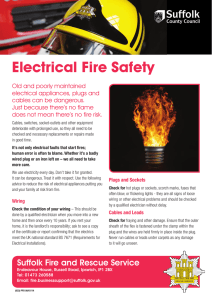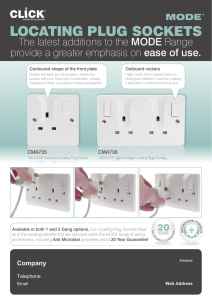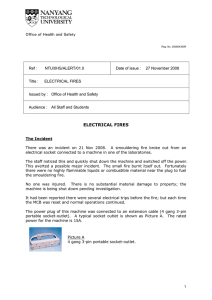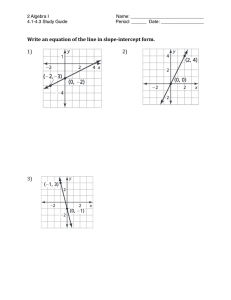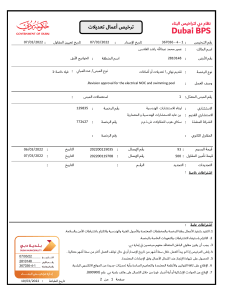Guidelines for Electrical Safety at Work
advertisement
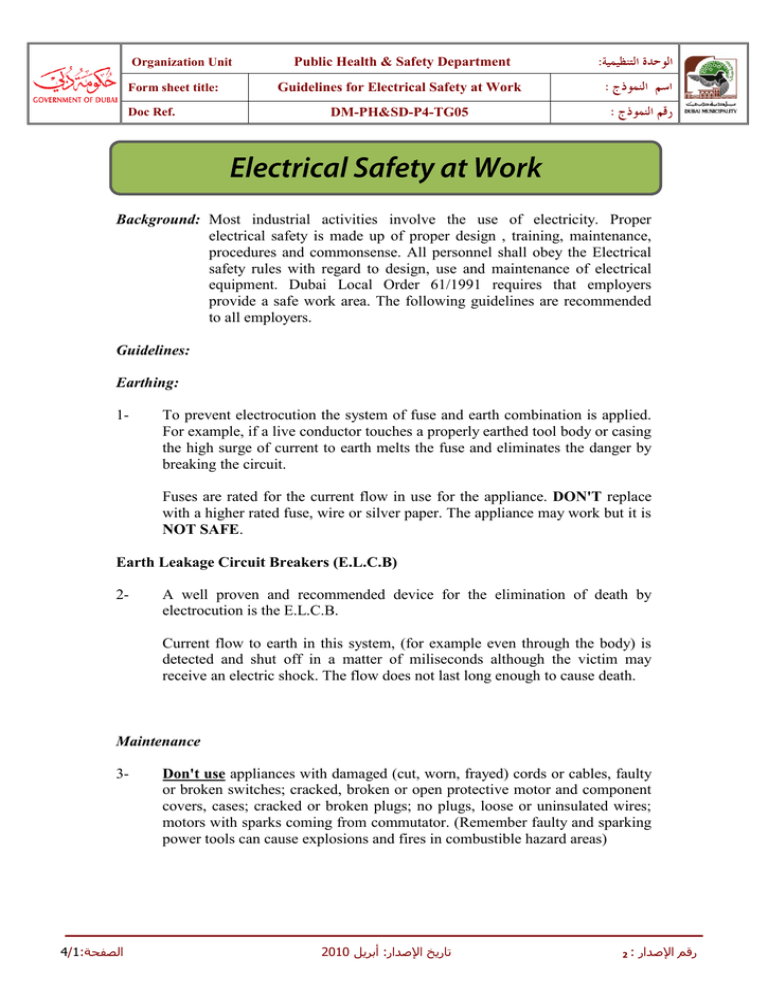
Organization Unit Form sheet title: Doc Ref. Public Health & Safety Department Guidelines for Electrical Safety at Work DM-PH&SD-P4-TG05 Background: Most industrial activities involve the use of electricity. Proper electrical safety is made up of proper design , training, maintenance, procedures and commonsense. All personnel shall obey the Electrical safety rules with regard to design, use and maintenance of electrical equipment. Dubai Local Order 61/1991 requires that employers provide a safe work area. The following guidelines are recommended to all employers. Guidelines: Earthing: 1- To prevent electrocution the system of fuse and earth combination is applied. For example, if a live conductor touches a properly earthed tool body or casing the high surge of current to earth melts the fuse and eliminates the danger by breaking the circuit. Fuses are rated for the current flow in use for the appliance. DON'T replace with a higher rated fuse, wire or silver paper. The appliance may work but it is NOT SAFE. Earth Leakage Circuit Breakers (E.L.C.B) 2- A well proven and recommended device for the elimination of death by electrocution is the E.L.C.B. Current flow to earth in this system, (for example even through the body) is detected and shut off in a matter of miliseconds although the victim may receive an electric shock. The flow does not last long enough to cause death. Maintenance 3- 4/1:الصفحة Don't use appliances with damaged (cut, worn, frayed) cords or cables, faulty or broken switches; cracked, broken or open protective motor and component covers, cases; cracked or broken plugs; no plugs, loose or uninsulated wires; motors with sparks coming from commutator. (Remember faulty and sparking power tools can cause explosions and fires in combustible hazard areas) 2010 أبريل:تاريخ اإلصدار 2 : رقم اإلصدار Organization Unit Form sheet title: Doc Ref. Public Health & Safety Department Guidelines for Electrical Safety at Work DM-PH&SD-P4-TG05 4- Don't tamper with any electric source; panels; outlet boxes etc. Get the electrician for any fault you spot. All electrical isolation/de-isolation should be done only by an authorized electrical person. 5- Never extend cables or cords with temporary ‘wire up and tape’ job. Get the electrician or approved extension reels. Design 6- Use Guards especially for rotating equipment such as drills, grinders, saws. Make sure power cable doesn’t get entrapped in rotating parts. 7- Protect all electrical equipment from ingression of water. E.g. rain, washing down. 8- When using portable power tools where no earth is available, always use approved double insulation appliances. Double insulation means that all metal parts are completely segregated (insulated) from the electric circuit and therefore require no earth. 9- Adequate steps must be taken to ISOLATE all danger areas. Sub-stations should be fenced off and locked (key with authorized electricians) with electrical hazard danger signs posted. Junction boxes, panels, distribution boxes - should be sign posted and firmly closed. No person without authority should enter any power station, transforming station or switch room. Procedures /Training 10- All electrical work shall be done only by an authorized trained, competent electrical person. 11- Never pull up a portable electric tool by the cable. Always carry it by the tool body. 12- Always switch off power and pull out the plug before changing parts on the tool, (such as the grinding disc) or making adjustments. 13- Never leave the power on when not using the tool. Remove plug from socket. 14- Don’t let electric cords or appliances come into contact with water. 15- Never insert loose wires of a tool cord into a socket. Always use a plug designed for the socket (e.g. never put a 2 pin plug in a 3 pin socket). 16- Keep cables away from heat sources. 4/2:الصفحة 2010 أبريل:تاريخ اإلصدار 2 : رقم اإلصدار Organization Unit Form sheet title: Doc Ref. Public Health & Safety Department Guidelines for Electrical Safety at Work DM-PH&SD-P4-TG05 17- Provide suitable padding and protection if tool cords have to pass sharp edges. 18- If the tool is overheating - don’t use it, get it inspected by a qualified electrician. 19- Keep power outlet panel doors closed after plugging in. 20- Never attempt to fix an electric appliance if you haven’t been trained to do so. 21- Keep all electric tools clean, free of dirt, dust and grease. 22- Use the proper personnel protective equipment when using electric power tools e.g. safety glassed or face shields, rubber soled shoes (avoid standing in water when using an electric appliance; use approved non-conductive rubber boots if absolutely essential). 23- Don’t place ladders (especially metal type) near any live electric wires. 24- Don’t remove any lock out or tags from electric sources. Only the instigator can remove these. 25- Overloading of multi-point connectors from a single outlet should be avoided. Check with electrician or find alternate supply. 26- Never accept cheap or sub standard wiring or equipment. All new permanent or temporary electric equipment and wiring should be approved by a qualified electrical engineer. 27- For hazardous areas (e.g. confined spaces, tanks, flammable atmosphere, etc.) only approved spark/flame proof cables and lighting should be used (Note: This applies to hand held torches also). Place adequate Number of CO2 fire extinguishers near electrical switch room. 28- In case of fire in any electric circuit NEVER use water as a means of extinguishing. 29- Train personnel in the dangers of electric hazards. Persons trained in basic first-aid for electric shock should be available. 30- Use lock out and tag out procedures when working on electric circuits coupled with permit to work system. 31- Encourage electric hazard spotting among employees such as a cracked plug etc. and get them to report fault for remedial action. 4/3:الصفحة 2010 أبريل:تاريخ اإلصدار 2 : رقم اإلصدار Organization Unit Form sheet title: Doc Ref. Public Health & Safety Department Guidelines for Electrical Safety at Work DM-PH&SD-P4-TG05 32- Non-electrical work to be carried out in the vicinity of exposed live parts should not start before the live parts have been safely covered to prevent access/contact. Danger notices should be placed. 33- Action all electrical faults immediately. 34- All dangerous occurrences and electrical accidents shall be investigated. FURTHER INFORMATION IS AVAILABLE FROM PUBLIC HEALTH AND SAFETY DEPARTMENT Tel: 2064244 / 2064282 FAX: 2270160 4/4:الصفحة 2010 أبريل:تاريخ اإلصدار 2 : رقم اإلصدار
